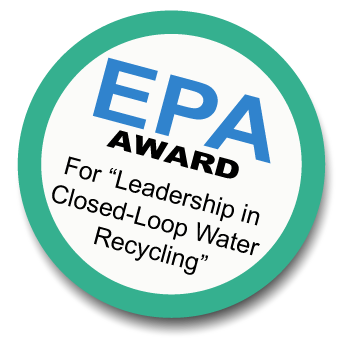Toxic Metal Contaminated
Ion-Exchange Resin Guarantee
Separation Technologists, Inc. GUARANTEES that the resin that we use to fill ion exchange tanks and all bulk resin sales are only for customers who are classified as toxic waste producers. None of the ion exchange resin that we sell is used for kidney dialysis patients, residential users, water for injection, research laboratories and other sensitive applications. Additionally, we are NOT a regenerator of spent resin. All spent resin received at our facility, which must first pass a Toxicity Characteristic Leaching Procedure (TCLP) test, is disposed of in an environmentally responsible manner according to Federal, State and local regulations.
Typical USA Ion-Exchange Regeneration Operation
More than 95% of the resin regenerators In the USA offer these services to the high purity user market, specifically, laboratory, hemodialysis, biotech, microelectronics, medical and others. The great majority will not accept any resin from any wastewater treatment process in their operations. Some may have separate building facilities to assure that no tanks from a wastewater treatment and high purity water applications are ever interchanged. A small minority will allow toxic metal contaminated resin into their facility. Some even take extra precautions using specially colored tanks in their operations. However, this does not prevent possible resin intermixing when the resin is removed from these tanks. Once toxic metal contaminated resin is in a facility, there is no 100% protection against operator error, a disgruntled employee, or other reason. Regardless, the generator is still responsible.
Why do you need a guarantee?
A toxic metal generator is responsible indefinitely, for any lead that was generated from recycling toxic-metal-contaminated water or anyone who handles the resin, regardless who misuses the resin, whether legally, illegally, or in error. This has been repeatedly upheld in the courts for decades. Today, the liability for the misuse of lead in the environment can be severe. Violation of environmental regulations can cost up to $25,000/day. Whenever toxic-metal-contaminated resin is moved and handled, cross-contamination will likely occur unless the regenerator only handles wastewater treatment resins.
Let's examine the ways that a non-wastewater regenerator could cross-contaminate your toxic metal contaminated resin with resins used in critical applications. Anytime the resin is transported and handled, there is a chance for a cross-contamination. Typically, operators remove the toxic metal contaminated resin from the original tanks and then treat the resins in other tanks or bulk regeneration tanks. Errors are likely despite the best efforts. In the past, Separation Technologists handled high purity resins, but after much experience we decided that operator errors were inevitable. We found that there was only one way to assure absolute protection to the toxic metal generator. That is, not to expose any resin used in critical applications to customers in kidney dialysis, research laboratories, or home drinking water applications. This was the decision that Separation Technologists made in January 1993. No one is more interested in preventing the misuse of lead-contaminated resin than you, the generator, therefore, you should make sure that your supplier uses the safest procedure possible.
Conclusion
The best way for an ethical resin supplier to assure that no resins are ever intermixed is to never allow the resin for the toxic metal market to be in same facility as the resin for the ultra high purity market. Also, the greater the number of parties between you and the ultimate disposal site, the greater the chance of misuse of the toxic-metal-contaminated resin and substantial increase in personal and corporate liability.

